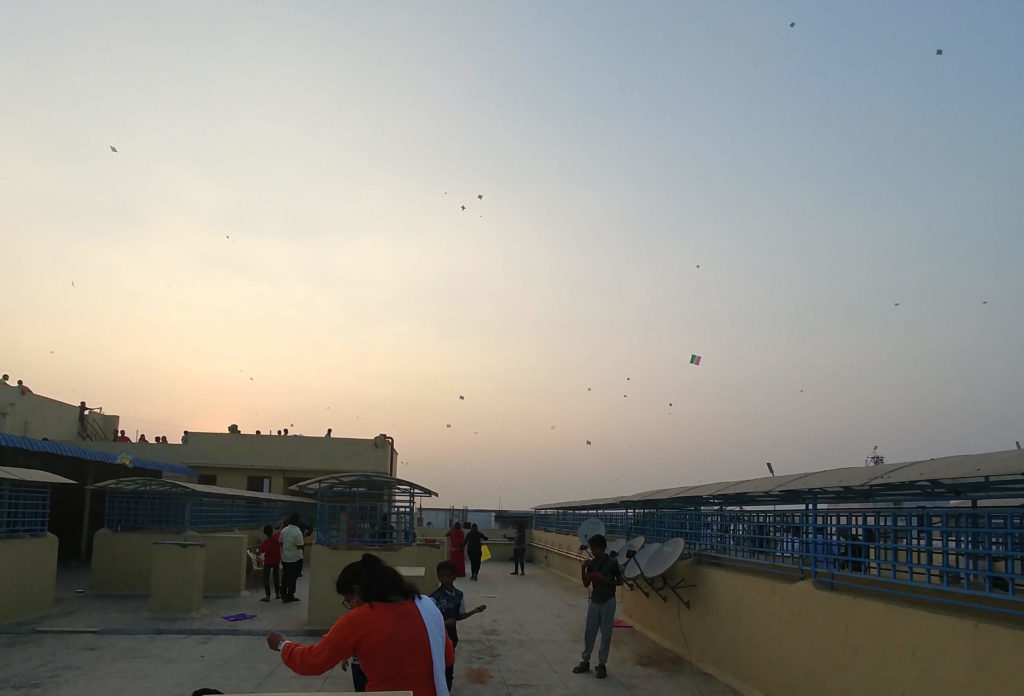About a week after I arrived in India, I experienced my first holiday–Sankranti, a Hindu holiday honoring the sun god Surya. People told me that it was a celebration of the winter solstice, which confused me, since the solstice had been about three weeks earlier. A little Wikipedia research explained it– the Hindu solar calendar doesn’t skip a leap year every hundred years (like our calendar does), so it slips by a day every 72 years. Thus, over the last 1,500 years or so, Sankranti moved to January 15 .
The first stage of Sankranti involves people making beautiful chalk drawings on the ground, and according to my Lonely Planet guide, decorating their best cows and proudly parading them through the streets. I was incredibly excited about the prospect of decorated cows. The naysaying of Mansi (one of my new bosses and temporary hosts) was not going to change my mind. At 7 am, I awoke to loud drumming and some not very melodious singing. Outside I found a very ordinary looking cow with a little bit of paint on it. Apparently, another part of the tradition is showing up outside people’s houses with your cow and singing loudly until they pay you to go away, but since we live on the third floor, we just waited the cow (or our neighbors) out.
Undaunted by my first Sankranti experience, I asked if we could go somewhere to see the kite festival, another traditional component of the holiday. Unbeknownst to me, my request set off a chain reaction of India’s legendary hospitality. Mansi called her father, who called an old schoolmate, who called his brother-in-law, and the next thing you know we’re headed into the old city.
Even generations after they’ve moved to the city, Indian families retain a lot of the traditions of the native state of their family. Rajasthan, the origin of my friend’s father’s schoolmate’s brother-in-law, is famous for its over-the-top hospitality, even by Indian standards. The family was all dressed in colorful, traditional Indian attire, and they proceeded to bring out tray after tray of snacks– dried fruit, nuts, about five different types of fried dough, and a delicious fried lentil dish. But the highlight was the multitude of sweets that are all pretty hard to describe. The most memorable and most delicious was the “Old Lady Hair,” named for its stringy texture and white color, which was eaten dipped in a rice pudding called kheer. (Sadly, I failed to take any pictures of the incredible spread. I’m also extremely glad I didn’t realize until after we had left that this was all occurring as a result of my request to see some kite flying .)
After stuffing ourselves full of dough and sweets, we grabbed a giant stack of paper kites (also provided by our incredible hosts) and headed to the roof. The kite string is coated in invisibly tiny shards of glass that make it sharp enough to cut another kite string but not your hand. The goal is to wrap your kite’s string around the string of an opponent’s kite, and then reel it in quickly, cutting it before they can cut yours.

The sky was full of kites as far as the eye could see. I tried snapping a few photos, but they can’t really do justice to how many kites there were in the sky. Every rooftop in sight was full of people, young and old, flying kites into battle.

I’m amazed Mansi managed to get a picture of me flying a kite, as I probably lasted about three minutes combined on my two kites. Our rooftop avoided attacking each other’s kites, so I don’t know who got me, but I like to imagine that my incompetence made some nearby 8-year-old very happy. But it just as easily could have been someone older than me. Our hosts and Mansi’s father were cutting kites left and right, despite having not flown them in years.
As night fell, the rooftops all lit up with floodlights illuminating the kites above. Chinese lanterns, kites with candles attached, and reflective kites filled the sky (but proved nearly impossible to photograph, unfortunately). We were told the festivities would continue until well after midnight, but having exhausted our kite supply and our energy, we headed home.
